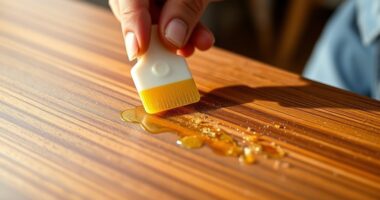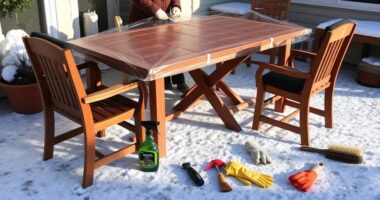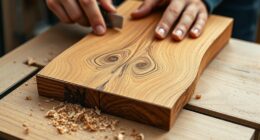For outdoor cedar, a combination of oil and varnish can offer the best protection and beauty. Oil penetrates deep, nourishing the wood and highlighting its natural grain, while varnish creates a hard, weatherproof surface that resists UV damage and scratches. This hybrid approach balances aesthetics with durability, reducing maintenance needs. To learn how to apply these finishes effectively and keep your cedar looking its best, discover strategies that maximize longevity and appearance.
Key Takeaways
- Oil finishes deepen cedar’s natural grain and warmth, enhancing aesthetic appeal with a matte, natural look.
- Varnishes provide durable, glossy protection against moisture, UV rays, and scratches, ideal for high-exposure areas.
- A hybrid approach combines oil’s deep penetration with varnish’s surface protection for optimal longevity and appearance.
- Regular maintenance is essential; oils require reapplication every 1-3 years, while varnishes last 3-5 years before re-coating.
- Proper surface preparation and weather conditions are critical for successful application and long-lasting outdoor cedar finishes.

Choosing the right outdoor cedar finish can dramatically enhance the durability and appearance of your wood. When deciding between oil, varnish, or a combination of both, understanding how each option interacts with weatherproofing techniques is key. Cedar is naturally resilient, but without proper protection, exposure to rain, sun, and fluctuating temperatures can cause it to warp, crack, or fade. Your goal is to select a finish that offers long-lasting protection while maintaining the natural beauty of the wood.
Oil finishes are popular because they penetrate deep into the cedar, nourishing the wood and highlighting its natural grain. They create a soft, matte look that enhances the warm tones of cedar. However, oils typically require more frequent maintenance schedules—usually every one to three years—to keep the wood protected and looking its best. Regularly applying oil helps maintain a weatherproofing barrier, preventing moisture from seeping in and causing damage. Keep in mind that oil finishes aren’t as resistant to scratches or UV rays, so they might need touch-ups more often in exposed areas.
Oil finishes penetrate deeply, nourish, and highlight cedar’s natural grain but need more frequent touch-ups for weather protection.
Varnishes, on the other hand, form a hard, glossy surface that provides excellent weatherproofing and protection against UV damage. They’re great for high-traffic or exposed outdoor structures because they resist scratches and moisture more effectively than oils. While varnishes generally require less frequent maintenance—every three to five years—they can peel or crack over time if not properly applied or if the wood shifts or expands with weather changes. To maximize their lifespan, you should implement suitable maintenance schedules that include cleaning and occasional re-coating. Proper surface preparation before application ensures better adhesion and a longer-lasting finish.
Some homeowners opt for a hybrid approach—using oil as a base coat to nourish the cedar and a varnish topcoat for added protection. This combination can offer the benefits of both finishes, providing deep penetration and a resilient surface. However, applying multiple coats means you’ll need to follow specific weatherproofing techniques, such as working in ideal conditions and allowing ample drying time between layers.
Ultimately, your choice depends on your climate, the specific cedar project, and how much ongoing maintenance you’re willing to perform. Regular inspections and adherence to maintenance schedules are crucial regardless of the finish you select. Proper upkeep ensures your cedar remains beautiful and protected, extending its lifespan and keeping it looking great for years to come. Additionally, understanding the self-watering plant pots concept can inspire innovative ways to maintain outdoor wooden structures by incorporating moisture management techniques.
Frequently Asked Questions
How Often Should I Reapply the Finish on Outdoor Cedar?
You should reapply the finish on outdoor cedar based on its maintenance frequency and weather impact. Typically, every 1-3 years is recommended, but if your area experiences harsh weather, like heavy rain or intense sun, you might need to reapply more often. Regular inspections help, so look for signs of fading, cracking, or peeling. Staying proactive guarantees your cedar stays protected and looks great longer.
Can I Mix Oil and Varnish for Better Protection?
You might think mixing oil and varnish is a good idea, but oil blending with varnish layering can lead to poor adhesion and uneven protection. Instead, apply them separately for ideal results, allowing each to cure properly. Combining these finishes isn’t recommended because it can compromise durability. Focus on choosing the right finish for your project and applying it correctly, ensuring your outdoor cedar stays protected and looking great longer.
What Is the Most Eco-Friendly Finish for Outdoor Cedar?
You want an eco-friendly finish for outdoor cedar, so look for alternatives that use natural preservatives and minimize environmental impact. Options like natural oils (such as linseed or tung oil) penetrate deeply while being biodegradable, and water-based sealers reduce harmful chemicals. These eco-friendly alternatives provide protection without harsh toxins, helping preserve the environment and your cedar’s beauty. Always check labels for eco certification to guarantee you’re choosing the most sustainable choice.
Does the Color of Cedar Affect Finish Choice?
Cedar color definitely influences your finish selection because lighter shades may require different treatments than darker ones to enhance their natural beauty. You might notice that a clear oil enhances the warm tones of light cedar, while darker cedar may benefit from a stain or protective coating that preserves its rich hue. Consider how the cedar’s color interacts with the finish to achieve a balanced, long-lasting look that highlights its natural charm.
How Do Weather Conditions Impact the Finishing Process?
Weather conditions considerably impact your finishing process. You should consider weather patterns and seasonal changes because high humidity, rain, or extreme temperatures can prevent proper drying and curing. Ideally, you want a dry, mild day with low humidity to apply your finish. Avoid working during rain or when temperatures fluctuate dramatically, as these conditions can compromise the durability and appearance of your cedar finish, leading to less effective protection.
Conclusion
Choosing between oil, varnish, or a combo is like picking the perfect outfit—each offers its own charm. Oil soaks in like a warm hug, highlighting cedar’s natural beauty, while varnish creates a glossy shield like armor. Combining them is like layering your favorite clothes—protection and style in one. Whichever route you take, remember, your cedar’s finish is the brushstroke that turns your outdoor masterpiece into a work of art.









